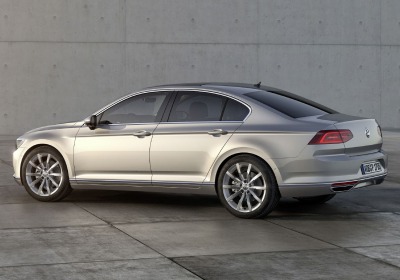First sight: Volkswagen Passat (2015)
Mon, 07 Jul 2014In recent years, European buyers have been switching their mid-size sedans and wagons for smaller cars, crossovers and SUVs. The Volkswagen Passat, Europe's most successful company car, has defined this market segment pretty much since it arrived back in 1973, and this latest, eighth-generation model has been designed to attempt to reverse that buying trend.
When we catch up with design director Dr Klaus Bischoff at the car's unveiling, he's certainly confident that the new car represents a significant step forward. "We had many proposals for this new generation of Passat. More than 20. But what I like about what we've ended up with is that we chose the exterior design that really was the most radical proposal."
The decision behind that choice by VW's board is a simple one. "The new car must reverse a trend of car designs in the mainstream D-segment at the moment. It must make buyers think 'I want that car' again," says Bischoff.
In order to implement this new design philosophy, the design team has taken advantage of VW's MQB architecture to improve the proportions. "Some dimensions can't be changed, like the dash to axle at the moment, but we see the MQB as a toolkit that allows us much more design freedom than our old platforms," says Bischoff. "We had a big fight with engineering to get the proportions we wanted."
Looking at the numbers, the Passat sedan is a little shorter, wider and lower than before. However, the wheelbase is longer, by 79mm, pushing the front wheels forward by 29mm and the rear wheels back by 17mm.
Although designed in Wolfsburg, VW AG's Potsdam facility was used for the launch because its larger presentation space could accommodate the media. When the show cars drive on stage, it's a pleasant surprise to see that the numbers above translate to a genuine difference.
You're first struck by the wide, low nose. The shorter front overhang helps, while the nose is more vertical than its predecessor's, too – the LED lamps are much more upright, while the grille is more reclined, with the two elements visually and physically linked by a chrome strip running along their top.
The Passat's more wedge-shaped profile owes plenty to the outgoing (Passat) CC, and has three major character lines. The most obvious is the crease that breaks across the front wheelarch then runs back through the door handles to the rear lamps. Then there's another that runs from the corner of the front lamp up the fender and gives a surface beneath the windows. Both do a decent job of adding the muscularity and solidity lacking from the previous model.
However, it's the third that Bischoff selects as most important; running up the hood, it traces a line up the A-pillar, over the roof and down the C-pillar to the rear lamp. It's the most subtle of the three, but is effective in visually lowering the roofline further than the 14mm the on-paper figures suggest.
He adds "every line on the car has a purpose, even if that purpose is beauty. On this car, it's the completeness of the design that counts, like the character lines and the chrome that doesn't just run along the rocker, it goes right around the car."
At the rear, you're convinced that the car can't be shorter than its predecessor, even if it's only a matter of 2mm. Changing the proportions gives a long rear deck that is more Phaeton than Passat. However, look closely, and there's an undercut running beneath the lamps subtly shortening the car, although your eyes read the character lines.
After the visual interest created by the exterior, it's hard not the be disappointed when you step inside. It's arguably more 'predictable' Passat, with an IP that's made of large, flat geometric surfaces, although the chrome horizontal lines of the vents mirror those of the front grille, and give the impression of width in the cabin. However, it feels like this feature could extend to run right around the cabin to echo the exterior more.
While the piano-black trim is a little dated, the Passat can be optioned up with tech. It's the first VW-badged car to get the Group's 12.3-inch TFT gauge pack (after the latest TT), while a head-up display is also offered for the first time.
The longer wheelbase gives 33mm extra length in the cabin, which translates to more space for your legs in the rear, while headroom seems pretty generous despite the lower roofline.
Asked for his take on the Passat's cabin, Bischoff says "While I agree that on first look the interior perhaps isn't quite as brave, there's a lot more going on there under the surface. Every function is now exactly where it should be. You think it's there and it's there."
We'll have to wait until we drive the car later in the year to find out this for ourselves. Likewise, only time will tell if the new design will reverse current trends and help reignite consumer enthusiasm for cars in this sector.
Related articles:
First Sight: Citroën C4 Cactus
Driven: Volkswagen Golf Mk7
By Tom Phillips

